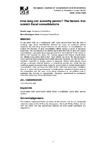How long can austerity persist? The factors that sustain fiscal consolidations

Ver/
Use este enlace para citar
http://hdl.handle.net/2183/23347Coleccións
Metadatos
Mostrar o rexistro completo do ítemTítulo
How long can austerity persist? The factors that sustain fiscal consolidationsData
2013Cita bibliográfica
Lodge, D., & Rodriguez-Vives, M. (2013). How long can austerity persist? The factors that sustain fiscal consolidations. European Journal of Government and Economics, 2(1), 5-24. https://doi.org/10.17979/ejge.2013.2.1.4284
Resumo
[Abstract] To put public debt on a sustainable path, many governments face the task of enacting large fiscal consolidation followed by years of sustained primary surpluses. By estimating hazard functions for the duration of consolidations, we analyse the features of past consolidation efforts across a panel of advanced economies. Our contribution is to identify the factors that help to start and sustain consolidations, separately discussing governments’ “commitment” to the cause as well as their “capacity” for action. Our analysis suggests that longer consolidations are initiated when public debt is high, fiscal deficits are large, the interest burden heavy and long-term sovereign bond yields elevated. However, we also find that a countries’ “capacity” to change course is important. Higher initial private sector savings, a stronger external balance, a competitive position and stable financial conditions appear to provide more scope for governments to sustain longer-lasting consolidations. Once we have controlled for the initial macroeconomic conditions, there is a lesser role for governments’ commitment as reflected in factors such as the composition and the pace of the fiscal adjustment or the political cycle in explaining the duration of consolidation. However, commitment to permanent, rather than temporary, fiscal adjustment is key.
Palabras chave
Government debt
Government deficit
Fiscal consolidation
Panel data
Survival function
Government deficit
Fiscal consolidation
Panel data
Survival function
Versión do editor
Dereitos
Atribución 4.0 España
ISSN
2254-7088






